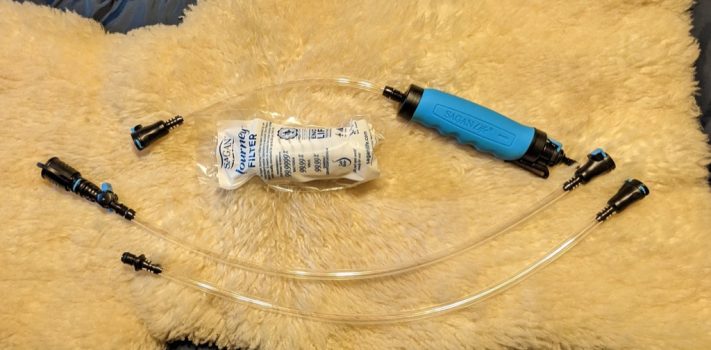We all need air, water, food, and protection from the environment (clothing and shelter). If we are deprived of any of these necessities for a long enough time, we will die.
Lack of access to clean drinking water can result in death through dehydration or disease. Emergency planning should include securing access to clean drinking water both at home and in the field.
I recently had the opportunity to test the Sagan Life XStream Straw Ultralight Water Filter Deluxe. It is light, easy to use, and effective. It is an excellent tool for preparing potable water under field conditions.
At the time of this writing, the Deluxe Kit with a pump and extra filter cost $79.99 from saganlife.com. The Basic Kit cost $39.99. Replacement filters cost $34.99.
Sagan Life also provided me with a sample of their AquaBrick Food and Water Storage Container. I found the AquaBrick to work well for transporting and storing water. It is durable, a convenient size and shape, is easy to fill, seals well, and pours well. At the time of this writing, a pack of two AquaBricks with a spigot cost $74.95 at saganlife.com.
First Impressions
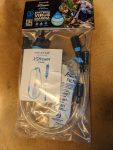 The XStream Straw kit arrived in a plastic bag stapled to a cardboard hanger. The hanger was imprinted with a host of helpful information:
The XStream Straw kit arrived in a plastic bag stapled to a cardboard hanger. The hanger was imprinted with a host of helpful information:
∙ The filter removes micro organisms, bacteria, viruses, Giardia, and heavy metals such as lead, mercury and arsenic.
∙ The filter cannot remove salt from water.
∙ Suggested uses include travel and vacation, outdoor activity, and emergency preparedness.
∙ Independent test results are available from aquaveritas.org .
∙ The filter meets or exceeds EPA water quality standards for up to 250 gallons of water.
The package contained a manual, filter, a mouthpiece with a 19 inch hose, another 19 inch extension hose, a pump with a 9.5 inch hose, and two brochures with information about Sagan Life’s other products. One of these brochures noted that the filter is made in the USA.
The manual consists of a simple 8.5 X 11 inch sheet printed on both sides and folded into quarters. It contains a host of helpful information as well:
∙ It provided simple directions for attaching the various parts of the system to the filter element.
∙ It contained a warning to always prefilter the water through a cloth or water screen if there is visible sediment and turbidity. Dirt and sediment will clog the filter and shorten its useful life.
∙ Care and maintenance: the manual advises air drying the filter for up to 2 weeks after use, and storing it in a box or other non-air-tight container to allow continued drying.
∙ The filtration process “incorporates an electro-positive charge which attracts and pulls particles as small as viruses out of the water while still maintaining high flow.”
∙ There is a one year limited warranty against defects in materials and workmanship. The warranty does not cover premature clogging due to the use of turbid water.
A slogan printed in the manual is “Make the Unthinkable Drinkable.”
Test # 1: Well Water
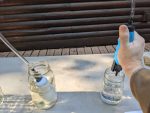 It was a beautifully sunny evening in early summer. There was a moderate breeze. The temperature was 67 degrees Fahrenheit. I went to the picnic table on our deck to test the filter. I took along the filter kit, a sample collection jar, a pour through coffee filter, a jar to collect the pre-filtered water, and a jar to collect the final filtered water.
It was a beautifully sunny evening in early summer. There was a moderate breeze. The temperature was 67 degrees Fahrenheit. I went to the picnic table on our deck to test the filter. I took along the filter kit, a sample collection jar, a pour through coffee filter, a jar to collect the pre-filtered water, and a jar to collect the final filtered water.
A hawk that nests near the deck was disturbed by my presence. It periodically screeched its displeasure at me throughout the testing process.
I began my testing with water from our well. The sample was clear with a faint yellowish hue. There was a faint odor of rust, with a hint of sulfur.
I poured the sample through the coffee filter into the pre-filtered collection jar. There was still a faint yellowish hue, and still a faint odor of rust with a hint of sulfur.
I opened the filter, connected it to the extension tube, and then connected the extension tube to the pump. I inserted the filter into the pre-filtered collection jar, and began to pump into the final collection jar.
The pump worked faster and more easily than I expected. The final collection jar was soon filled with filtered water.
The filtered water was perfectly clear, with no hint of discoloration. There was no discernable odor, and the water tasted great with no hint of dissolved minerals. I was very impressed. I had tested another portable water filter system with our well water in the past, and found it incapable of removing the taste of dissolved minerals. The XStream Straw exceeded my expectations.
Test #2: Rain Barrel Water
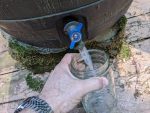
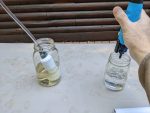 It would be reasonable to expect water from a rain barrel to be quite pure. Unfortunately, that is not the case for the water from our rain barrels. Leaves, blossoms, seeds, pollen, bird and bat droppings and other unappetizing items fall on our roof. There these items break into small enough pieces to wash through the screens on our rain barrels. Inside the rain barrels, these pieces decay, leaving the water in the barrels with a strong sulfur smell. The water is great for watering plants, but most people would gag at the thought of drinking it.
It would be reasonable to expect water from a rain barrel to be quite pure. Unfortunately, that is not the case for the water from our rain barrels. Leaves, blossoms, seeds, pollen, bird and bat droppings and other unappetizing items fall on our roof. There these items break into small enough pieces to wash through the screens on our rain barrels. Inside the rain barrels, these pieces decay, leaving the water in the barrels with a strong sulfur smell. The water is great for watering plants, but most people would gag at the thought of drinking it.
The water that I collected in the sample jar was pretty typical for our rain barrels. It had a slight yellowish hue and a strong sulfur smell.
I poured the water through the coffee filter into the pre-filtered collection jar. It retained its yellowish hue and strong sulfur smell.
I inserted the filter into the pre-filtered collection jar, and pumped water into the final collection jar until it was full. The yellow hue was gone, as was the sulfur smell. The water tasted great, with no hint of decay.
Once again, I was impressed.
Test #3: Pond Water
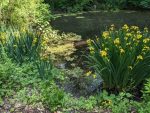 For the third test, I gathered a sample from our pond, which is currently covered with an unappetizing layer of pollen and duck weed. The water level was somewhat low, making it difficult to collect a sample without getting stuck in the mud. I threw a log over the mud, and stood on the log while collecting a sample. As a result, the sample had a generous helping of disturbed mud mixed in with the water. It also had some duck week floating on top. The water looked muddy and smelled just like the muddy pond water that it was.
For the third test, I gathered a sample from our pond, which is currently covered with an unappetizing layer of pollen and duck weed. The water level was somewhat low, making it difficult to collect a sample without getting stuck in the mud. I threw a log over the mud, and stood on the log while collecting a sample. As a result, the sample had a generous helping of disturbed mud mixed in with the water. It also had some duck week floating on top. The water looked muddy and smelled just like the muddy pond water that it was.
I poured the sample through the coffee filter into the pre-filtered collection jar. The water ran through the filter more slowly than usual because the mud filled the pores of the filter. The water that collected in the jar below had a brown/yellow hue, and a faint odor of sulfur.
I inserted the filter into the pre-filtered collection jar, and pumped water into the final collection jar until it was full. The brown/yellow hue was gone, as was the sulfur smell. The water tasted great, with no hint of mud, frogs, turtles, or decaying vegetation.
I was very impressed with the performance of the XStream Straw. It did a good job of providing pure delicious drinking water from three sources tainted with various unpleasant substances.
The AquaBrick
The AquaBrick is a water storage container that is approximately 17 x 8.5 x 6.5 inches in size. It is made of heavy gauge BPA free HDPE plastic. It can hold 3 gallons of water. It can also be used as a food storage container that can hold up to 20 pounds of food.
I found the AquaBrick’s 3-gallon size to be very convenient for carrying water. A full 5-gallon container can be a bit on the heavy side. A 1-gallon container tends to be too small. The three-gallon size is just right.
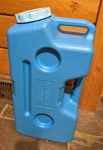 There are handles on two sides of the AquaBrick. The handle next to the lid is just a bit small for hands my size. The other handle is big enough to accommodate even the largest hands. The wide opening was easy to fill, and the sturdy lid sealed it well. The containers are designed to stack, and stacking them will place the lids on the sides of the containers rather than on the top. This seems like an invitation for someone to forget to tighten a lid sufficiently, and for the container to leak. But the container poured quite well with the lid in its current location. Moving the lid would make the container less susceptible to leakage, but more difficult to pour from.
There are handles on two sides of the AquaBrick. The handle next to the lid is just a bit small for hands my size. The other handle is big enough to accommodate even the largest hands. The wide opening was easy to fill, and the sturdy lid sealed it well. The containers are designed to stack, and stacking them will place the lids on the sides of the containers rather than on the top. This seems like an invitation for someone to forget to tighten a lid sufficiently, and for the container to leak. But the container poured quite well with the lid in its current location. Moving the lid would make the container less susceptible to leakage, but more difficult to pour from.
I transport a lot of water. We are not fans of the taste of our well water. So I fill gallon jugs with water at work and carry all of our drinking water home from there. Gallon milk jugs can only be stored for a limited time before they begin to leak. Gallon lemonade and iced tea jugs from Chick-fil-a are much sturdier. I have never had problems with any of them. Based upon the sturdy construction of the AquaBrick, I would expect it to last even longer than the gallon jugs from Chick-fil-a.
Conclusions
The XStream Straw gave excellent results in my testing. It is light, easy to use, and effective. It provides an excellent tool for preparing potable water under field conditions.
The AquaBrick worked well for transporting and storing water. It is durable, a convenient size and shape, is easy to fill, easy to pour, and seals well.
Disclaimer
Sagan Life was kind enough to provide me with a sample of their Xstream Straw for testing and evaluation. I tried not to let their kindness interfere with my objectivity in this review, and believe that I have succeeded. I did not receive any other financial or other inducement to mention any vendor, product, or service in this article.

